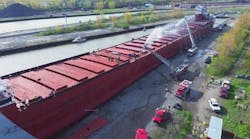At approximately 9:30 A.M. on Dec. 15, 2005, a fire of undetermined origin broke out in the main building of the historic Lake Placid Lodge, which sits on 10 acres of prime real estate in upstate New York. The main building holds a restaurant, cocktail lounge and wine cellar. The fire was initially reported as starting in a non-operational lower-floor kitchen adjacent to a boiler room, closets and other utility rooms. The current, working kitchen is one floor above the older one.
Lake Placid is a resort village 275 miles from Boston and New York City and 112 miles north of Albany. It lies within the more than six-million-acre Adirondack Mountains region. The village hosted the 1932 and 1980 Winter Olympics and is renowned for winter and summer recreational activities. Money derived from tourism is a vital ingredient to the village’s economic health.
With 34 rooms, cabins and suites, the lodge is one of the most exclusive mountain retreats in North America. It was built in 1882 as a private camp. In 1946, it was enlarged to a hotel and in 1994 it was purchased by the current owners, the Garrett Group, which owns and manages other first-class resorts. The lodge, which sits along the forested south shore of Lake Placid, has received numerous honors, including being named by the Zagat Survey as one of the Top 20 U.S. Small Hotels and Resorts, and Conde Nast Traveler named it one of the three best lakeshore hotels in North America. Rooms start at $400 a night and skyrocket to $1,300 a night. Meals with vintage wines can easily cost hundreds of dollars.
The year-round population of Lake Placid is 7,500, but that number can swell to 30,000 on any given weekend due to the tourism industry. Lake Placid hosts myriad events, including the Goodwill Games, the Fire Association of the State of New York Winter Games, and figure skating, bobsled, skeleton, luge, skiing, ski jumping, hockey, Ironman USA, rugby, lacrosse and soccer events. It is also home to the Olympic Training Center.
The Lake Placid Volunteer Fire Department has 10 professional firefighters, 60 volunteers and six paid drivers based in one centralized station that protects 122 square miles. The buildings in its jurisdiction are a combination of residential and business. Wood construction, mostly using native materials, is used in residential buildings. New construction in the business district is for the most part steel.
The first alarm for the fire at the lodge came in at 9:43 A.M. and the department responded with two engines. Paid Fire Driver Matthew Colby and Head Fire Driver Brad Jaques drove the rigs. At the time of the fire, between 10 and 15 employees were at the lodge. No guests were registered at the time. The temperature was an arctic 1 degree Fahrenheit and the relatively narrow roads were snow covered and icy.
“The fire was called in by a female employee from the Lodge who gave us the wrong name and address,†said Fire Chief Jim Wasson, the incident commander. “She also stated it was a fire in the kitchen.â€
Responders initially went to Whiteface Lodge, a separate recently completed lodge about a mile away, but the detour did not compromise operations.
“Whiteface Lodge is on the same road as Lake Placid Lodge,†Wasson said. “When First Assistant Chief William Moore arrived on the scene, there was already heavy fire. The Saranac Lake Fire Department and Ausable Forks Fire Department each sent one engine to back-cover our station.†Within 20 minutes, the dining room was engulfed in flames.
“The main building is in very close proximity to the other buildings,†Wasson explained. “We were able to save the main entrance building with aggressive firefighting tactics. We were able to keep the fire contained to the structure behind the main building, which was in danger all the time.â€
Firefighters applied a covering of foam to the second structure, known as the “link building.†The chief said, “We finally had to tear down the link building with a backhoe we brought in, in order to stop fire from spreading further into the main structure.â€
Smoke generated by the fire was visible at least 20 miles away. No injuries were reported, although an estimated $250,000 worth of wine was in the destroyed cellar. Kim Rielly, director of communications for the Lake Placid Chamber of Commerce, estimated the loss caused by the fire to the local economy for the day after Christmas to New Year’s Day to be approximately $500,000.
Mutual Aid
Approximately 150 firefighters from Lake Placid and other communities were involved in fighting the blaze. The Tupper Lake Fire Department sent 10 firefighters; the Saranac Lake Fire Department sent an engine, a tanker and a rescue with 15 firefighters; the Lake Placid Ambulance Service dispatched two ambulances; the Wilmington Fire Department sent an engine and tanker and six firefighters; the Keene Fire Department sent five firefighters with a tanker and an ambulance; and Essex County Emergency Services sent six responders. Additionally, the Keene, Keene Valley, Jay and Upper Jay, Ausable, Bloomingdale and Wilmington tanker task force and 15 firefighters also responded. Officers from the Lake Placid Police Department and New York State Police also responded, and state forest rangers helped with crowd control. The Dickinson Center and St. Regis Falls fire departments helped staff Saranac Lake’s firehouse.
Mutual aid coordination and communication were accomplished easily, Wasson said, because “when the initial size-up was taken at the scene, mutual aid was automatic for us. The pre-arranged tanker task force was mobilized and shortly on the scene working. It is nice to have such dependable departments in such close proximity and run so efficiently. Other apparatus were called in on an as-needed basis. Communications were good.â€
Major Challenges
The most significant challenges facing firefighters were the weather and manpower. “Cold and snow,†Wasson said. “At alarm time, it was 1 degree. Freezing equipment was always on our minds and became a priority. Manpower was low because of many work obligations. The firefighters worked hard in cold weather for long periods of time. It was a lot to ask of them. However, all of them came through when it counted.â€
He continued, “Another challenge was limited access to the property. There’s basically only one way in and out. Terrain was also a consideration. The slope of the hill (leading to the main entrance building) was steep.†It took firefighters more than seven hours to put out the flames. In addition to tankers, water was drafted from Lake Placid.
“Severe weather always poses a problem for rural departments,†Wasson said. “Being prepared for disaster is the key to efficiency. Perhaps the biggest lesson is pre-planning for all structures in the area is the key to success.â€
He evaluated the response as, “Excellent. I thought overall operations ran very well and could not have gone better. I felt the area departments did an outstanding job and made me proud to be a volunteer in this part of the world. All EMS personnel worked well together.â€
At 1:49 P.M. the following day, Lake Placid firefighters returned to the lodge to extinguish a small flare-up. The scene was secured at 3:19 P.M.
Michael Garlock is a Florida and New York-based writer specializing in fire service responses to major incidents.






